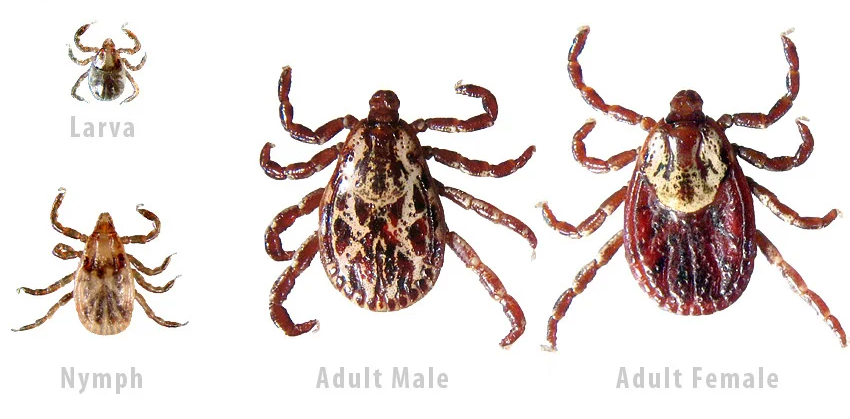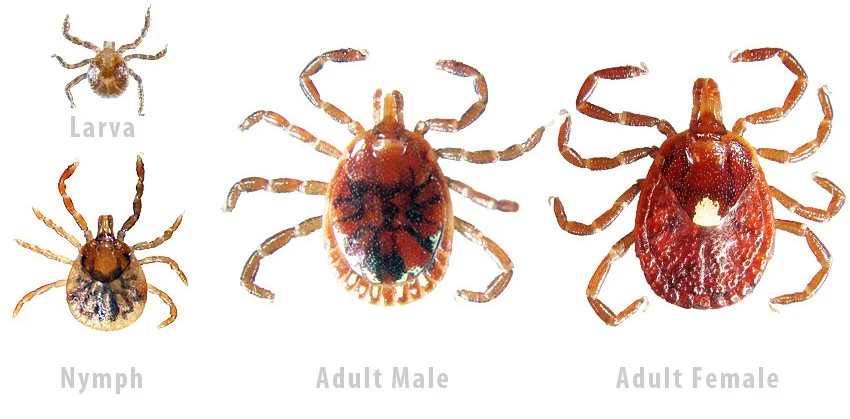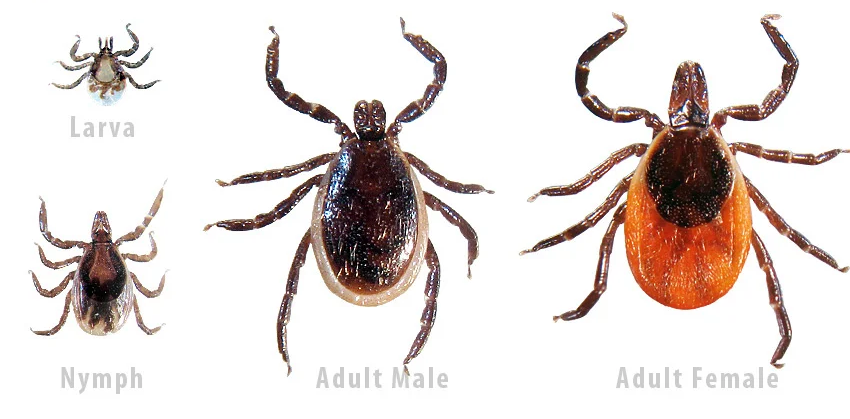Instructions for use
Fine tipped tweezers
(Ideal for removing small ticks)

STEP 1
Grip the tick close to the skin's surface.

STEP 2
Pull upward with steady, even pressure. NEVER twist or jerk the tick out.
Slotted scoop
(Ideal for removing large ticks)

Step 1
Place the slotted scoop against the skin, sliding it under the tick's mouth parts.

STEP 2
Lift the tick carefully from the skin with steady, even pressure.
Checking for ticks
For People
When checking for ticks, pay special attention to these areas:
- Along your hairline
- Groin
- Around/In the ears
- Legs
- Back of your neck
- Behind the knees
- Armpits
- Between your toes
Use a hand-held or full length mirror to view all parts of your body for ticks.

Larva

Nymph

Adult Male

Adult Female
For pets
Examine your pet thoroughly from tail to nose, especially the neck, head, and around the ears as ticks like to embed themselves in these areas. Searching is made easier by separating the fur and examining the skin.
- Under the collar
- Under the tail
- Inside the groin area
- Between the toes
- Under the front legs
- Elbows
- Even on the eyelids!
Some ticks can be the size of a sesame seed.
Some species of ticks are no bigger than a grain of sand.
Common ticks in the usa
Helpful tips
Double sided design
Remove ticks with ease using the only available dual-tipped tick removal device on the market, allowing you to remove ticks from humans & animals with just one tool.
Made for people + pets
Featuring fine-tipped tweezers for removing even the smallest ticks, and a slotted scoop for removing larger ticks.
Removes ticks of all sizes
Unlike regular household tweezers, our reliable tick removal tool detaches ticks safely and effectively and meets CDC guidelines for tick removal.
100 stainless steel
Made from durable stainless steel, our high-quality tick remover can withstand the heat from an autoclave for sterilization.
Compact practical + handy
Out hiking, camping, or traveling? Take your handy Bug Bite Thing Tick Remover for emergency tick removal anytime, anywhere for you or your pets.
Top Ten Things Everyone Should Know About Ticks:
-
Tick bites and tick borne diseases are completely preventable:
There's really only one way you get a tick-transmitted disease, and that's from a tick bite. Reducing tick abundance in your yard where you spend a lot of time, wearing tick-repellent clothing every day, treating pets every month with tick-repellent spot-on products, getting into a habit of doing a quick body scan for attached poppy-seed-sized or larger ticks, and pulling ticks off quickly and safely are all great actions for preventing tick bites. These days, ticks are more than just an annoyance. One bite can make you sick, even change your life! Remember these 10 things, and you'll stay safer.
-
Clothing with built in tick repellent is best for preventing tick bites:
An easy way to avoid tick bites and disease is to wear clothing (shoes, socks, shorts or pants, and a shirt) with permethrin tick-repellent built-in. This strategy can be especially effective for protecting children. Dressing kids in tick-repellent clothes daily is a safe and easy way to keep ticks from biting and transmitting disease. Commercially-treated tick-repellent clothes last through at least 70 washes, while using kits or sprays to treat your current outdoor wardrobe can last through 6 washes. Tick repellent on clothing, not skin, is something everyone needs to know about to stay safe outdoors.
-
The easiest and safest way to remove a tick is with a pointy tweezer:
Think of a tick as a little germ-filled balloon. Squeeze it too hard on its back end, and all the germs get pushed to the front end, which by the way, is attached to you by the tick's straw-like mouthpart. Using really pointy tweezers, it's possible to grab even the poppy-seed-sized nymphs right down next to the skin. The next step is to simply pull the tick out like a splinter. Don't worry if the mouthpart stays in your skin as long as you've got the rest of the tick by its head. Other tick removal methods, like a hot match, Vaseline, dish soap and cotton, or various little key-like devices, don't work as consistently as pointy tweezers on all types of ticks. Remember to save the tick and try to identify it (see #6).
-
Deer tick nymphs look like a poppy seed on your skin:
And with about 1 out of 4 nymphal deer ticks carrying the Lyme disease spirochete and other nasty germs in the northeastern, mid-Atlantic, and upper mid-western U.S., it's important to know what you're really looking for. They're easy to miss, their bites are generally painless, and they have a habit of climbing up (under clothing) and biting in hard-to-see places.
-
For most tick borne diseases you have at least 24 hours to find and remove a Feeding tick before it transmits an infection:
Even a quick daily tick check at bath or shower time can be helpful in finding and removing attached ticks before they can transmit an infection. You'll probably want to check even more carefully if you know you've likely been exposed. Many of the disease- causing microbes transmitted by ticks need a "reactivation" period in the tick once it begins to feed. The germs eventually make their way into the tick's salivary glands, and the tick spits them into you while feeding. Some infections, especially viruses, move into the tick salivary glands faster than others. Lyme disease bacteria take at least 24 hours to invade the tick's saliva.
-
Only deer ticks transmit lyme disease bacteria:
The only way to get Lyme disease is by being bitten by a deer tick or one of its "cousins" found around the world. Deer ticks also are known as blacklegged ticks in the U.S., sheep ticks in Europe, or Taiga ticks in Asia. Dog ticks, Lone Star ticks, and other types of ticks don't seem to be able to transmit Lyme disease. While that's good news, it makes saving any tick that you find biting more important so you can identify it. Doing so may save a lot of unnecessary doctor visits and treatments.
-
Ticks carry disease causing microbes:
Tick-transmitted infections are more common these days than in past decades. With explosive increases in deer populations, extending even into semi-urban areas in the eastern and western U.S., the trend is for increasing abundance and geographic spread of deer ticks and Lone Star ticks, and scientists are finding an ever-increasing list of disease-causing microbes transmitted by these ticks: Lyme disease bacteria, Babesia protozoa, Anaplasma, Ehrlichia, and other rickettsia, even encephalitis-causing viruses, and possibly Bartonella bacteria. Back in the day, tick bites were more of an annoyance, but now a bite is much more likely to make you sick.
-
Ticks can be active even in the winter:
That's right! Adult-stage deer ticks become active every year after the first frost. They're not killed by freezing temperatures, and while other ticks enter a feeding diapause as day lengths get shorter, deer ticks will be active any winter day that the ground is not snow-covered or frozen. This surprises people, especially during a January thaw or early spring day. Remember this fact, and hopefully, you'll never be caught off-guard.
-
All ticks including deer ticks come in small medium and large sizes:
Ticks hatch from eggs and develop through three active (and blood-feeding) stages: larvae (small-the size of sand grains), nymphs (medium-the size of poppy seeds), and adults (large-the size of apple seeds). If you see them bigger, they're probably partially full or full of blood.
-
Ticks crawl up:
Ticks don't jump, fly, or drop from trees onto your head and back. If you find one attached there, it most likely latched onto your foot or leg and crawled up over your entire body. Ticks are "programmed" to try and attach around your head or ears. On their normal hosts, ticks also usually crawl up; they want to blood feed around the head, neck, and ears of their host, where the skin is thinner, and hosts have more trouble grooming.


